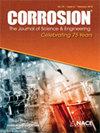Hydrogen embrittlement and its prevention in 7XXX aluminum alloys with high Zn concentrations
IF 1.3
4区 材料科学
Q4 MATERIALS SCIENCE, MULTIDISCIPLINARY
引用次数: 0
Abstract
7xxx aluminum alloys are representative high-strength aluminum alloys; however, mechanical property degradation due to hydrogen hinders further strengthening. We have previously reported that hydrogen embrittlement in 7xxx alloys originates from trapped hydrogen at the MgZn2 precipitate interface, providing high hydrogen trapping energy. We propose the dispersion of Mn-based second-phase particles as a novel technique for preventing 7xxx aluminum alloy hydrogen embrittlement. In this study, the deformation and fracture behaviors of high hydrogen 7xxx alloys containing 0.0% Mn and 0.6% Mn are observed in situ using synchrotron radiation X-ray tomography. Although no significant differences appear between the two alloys regarding the initiation of quasicleavage cracks, the area fractions of final quasicleavage fractures are 16.5% and 1.0% for 0.0%Mn and 0.6%Mn alloys, respectively; this finding indicates that the Mn addition reduces hydrogen-induced fractures. The obtained macroscopic hydrogen embrittlement is quantitatively analyzed based on hydrogen partitioning in alloys. Adding 0.6% Mn, generating second-phase particles with high hydrogen trapping abilities, significantly suppresses hydrogen-induced quasicleavage fracture. The results of an original hydrogen partitioning analysis show that the dispersion of Mn-based particles (Al12Mn3Si) with high hydrogen trapping abilities reduces the hydrogen concentration at the semicoherent MgZn2 interface and suppresses hydrogen embrittlement.7XXX高锌铝合金的氢脆及其预防
7xxx铝合金是具有代表性的高强度铝合金;然而,由于氢导致的机械性能退化阻碍了进一步的强化。我们之前已经报道过7xxx合金中的氢脆源于MgZn2沉淀界面处的氢捕获,提供了高的氢捕获能。我们提出分散Mn基第二相颗粒作为一种防止7xxx铝合金氢脆的新技术。在本研究中,使用同步辐射X射线断层扫描原位观察了含有0.0%Mn和0.6%Mn的高氢7xxx合金的变形和断裂行为。尽管两种合金在准解理裂纹萌生方面没有显著差异,但0.0%Mn和0.6%Mn合金的最终准解理裂纹的面积分数分别为16.5%和1.0%;这一发现表明Mn的添加减少了氢诱导的断裂。基于合金中氢的分配,对获得的宏观氢脆进行了定量分析。添加0.6%的Mn,产生具有高氢捕获能力的第二相颗粒,显著抑制了氢诱导的准解理断裂。原始氢分配分析的结果表明,具有高氢捕获能力的Mn基颗粒(Al12Mn3Si)的分散降低了半相干MgZn2界面处的氢浓度,并抑制了氢脆。
本文章由计算机程序翻译,如有差异,请以英文原文为准。
求助全文
约1分钟内获得全文
求助全文
来源期刊

Corrosion
MATERIALS SCIENCE, MULTIDISCIPLINARY-METALLURGY & METALLURGICAL ENGINEERING
CiteScore
2.80
自引率
12.50%
发文量
97
审稿时长
3 months
期刊介绍:
CORROSION is the premier research journal featuring peer-reviewed technical articles from the world’s top researchers and provides a permanent record of progress in the science and technology of corrosion prevention and control. The scope of the journal includes the latest developments in areas of corrosion metallurgy, mechanisms, predictors, cracking (sulfide stress, stress corrosion, hydrogen-induced), passivation, and CO2 corrosion.
70+ years and over 7,100 peer-reviewed articles with advances in corrosion science and engineering have been published in CORROSION. The journal publishes seven article types – original articles, invited critical reviews, technical notes, corrosion communications fast-tracked for rapid publication, special research topic issues, research letters of yearly annual conference student poster sessions, and scientific investigations of field corrosion processes. CORROSION, the Journal of Science and Engineering, serves as an important communication platform for academics, researchers, technical libraries, and universities.
Articles considered for CORROSION should have significant permanent value and should accomplish at least one of the following objectives:
• Contribute awareness of corrosion phenomena,
• Advance understanding of fundamental process, and/or
• Further the knowledge of techniques and practices used to reduce corrosion.
 求助内容:
求助内容: 应助结果提醒方式:
应助结果提醒方式:


